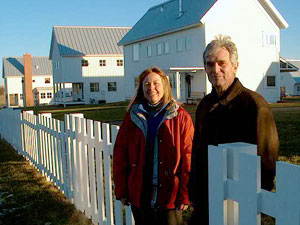|
Audio
Photos
Your Voice
|
Jackson Meadow aims to be model for sustainable growth
January 13, 2003
 |
| Developers Harold and Carol Teasdale at Jackson Meadow (MPR Photo/Marisa Helms) |
Marine on St. Croix, Minn. — From the clean lines of the stark white houses and picket fences, to self-sufficient energy sources, Jackson Meadow presents a picture of environmental idealism.
The development is about 300 acres, but most of that is undeveloped green space. The 25 homes built so far are clumped together on just 40 acres.
 | |||
Project developer Harold Teasdale says the high density construction intentionally places the landscape center stage.
"Our goal that's been lurking behind everything we've been doing right here is how do you do a sustainable community, and how to you do it in such a way so as not to destroy the very reason people show up in that space in the first place," according to Teasdale.
Teasdale put 230 acres of the development into a conservation easement. Jackson Meadow will eventually hold 64 houses, but the easement means that 230 acres cannot be developed no matter the political or zoning climate in the future. And, instead of individual back yards, Jackson Meadow residents share just over 100 acres of open space. Restored prairie grasses, and walking trails cut through soft rolling hills.
Each house is designed for energy self sufficiency. They are pre-slated and ready for photovoltaic solar panels. Several of the houses have geo-thermal heating and cooling. The development has its own organic septic system. And for the past few years, Teasdale has been trying to get wind energy on the land. He says it's been a challenge to swim against the conventions of traditional real estate development.
"Jackson Meadow is all about pushing upstream," says Teasdale. "There's this whole system in place. You just have to be willing to get a whole series of 'No's,' and keep asking the question, and asking the question, ask 'why not, why not, why not?' until you can finally bust through and get someone to say, 'well maybe if this is done this way,' then suddenly, 'yeah, I guess it would work if you did it that way.' And all you're looking for is that opening."
Teasdale's persistence is paying off. Jackson Meadow won the 2002 Land Use Award from the Minnesota Environmental Initiative - a consortium of state environmental interests.
 | |||
And people are buying houses in Jackson Meadow. Several, mostly young, families have moved in. Many say they are attracted to the sense of community they find there.
Self-described stay-at-home-mom Jody Nyenhuis, her husband, and three children left south Minneapolis for Jackson Meadow.
"I don't have bad feelings about the city in any way," she says. "It think it would have been either stay right in the heart of it, or move out in the boondocks. Which this feels like a little bit. That you're out in middle of country yet you're with neighbors. You have both country and neighbors. I love that."
Living at Jackson Meadow isn't for everyone. The houses start at about $400,000. The development is exclusive in another way: its aesthetic is very particular. Those who buy in Jackson Meadow must paint their houses only white and conform to an A-frame, box-type architectural style and a detached garage.
And, despite the idealism Jackson Meadow's developers hope to present, there are some who see the project as impractical in environmental terms.
Lee Ronning is president of 1000 Friends of Minnesota, an organization that promotes smart growth. She says Jackson Meadow misses the mark in a couple of important ways.
"While they have a number of really positive, innovative features for at least Minnesota, and we should congratulate them on that, it doesn't provide all of the elements in smart growth. There would have to be a mix of housing to provide more affordable housing. There would need to be a mix of uses so people wouldn't have to drive into their automobiles to the community to take care of their daily needs."
Developer Teasdale and Jackson Meadow residents are aware of the criticism. But, Teasdale, who lives there, believes he is setting an example by driving a hybrid electric car. He says many residents are trying to work from home as much as possible. And many have started a buying club that delivers food to the development.
"The people who show up here are already thinking a particular way. I believe this to be true. So it's more or less showing the way rather than saying 'do it this way.' Saying, 'here's a path to go down, want to try it?' And our goal is to make it so attractive, the answer is 'well, of course.'"
Local environmentalists say sustainable communities are increasingly recognized as good public policy for managing growth and leaving less of an environmental mark. Still, they admit, convincing people to live closer together and share green space is a little far out for many who have the money to live where, and how, they please.
|
News Headlines
|
Related Subjects
|
